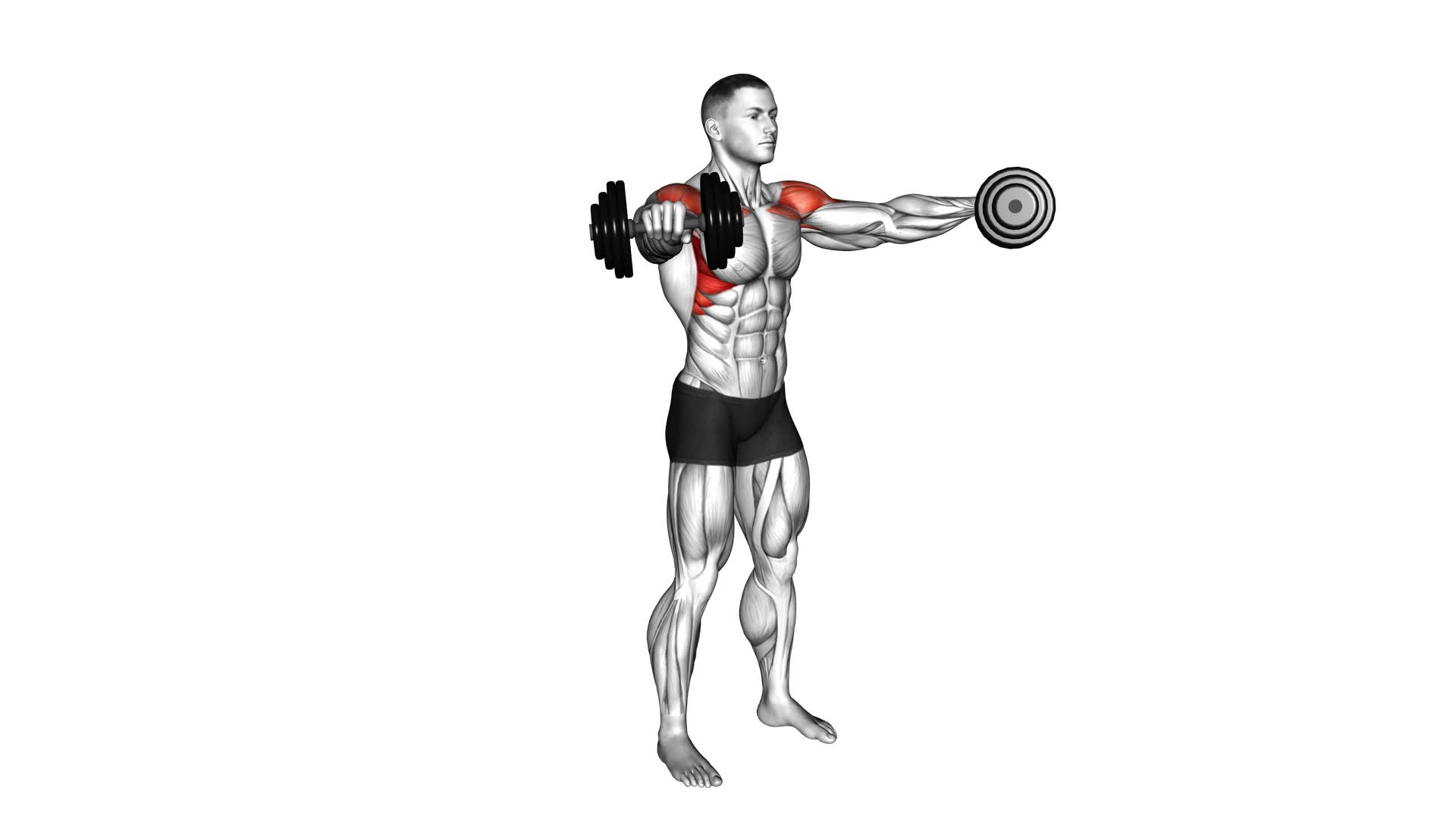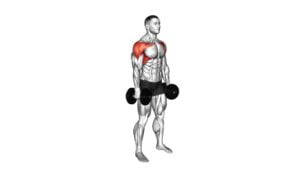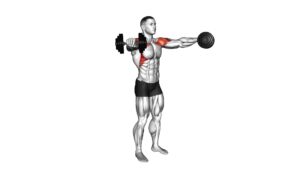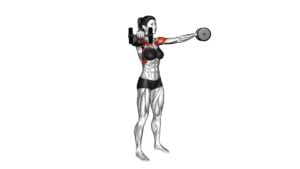Dumbbell Standing Front to Lateral Raise – Video Exercise Guide & Tips

Looking to amp up your shoulder workout? Check out the Dumbbell Standing Front to Lateral Raise. This exercise targets your deltoids and helps improve shoulder strength and stability.
Watch This Exercise Video
In this video exercise guide, we'll walk you through the proper technique, common mistakes to avoid, and variations to spice up your routine. Plus, we'll share tips for getting the most out of your shoulder workout.
Get ready to take your shoulder gains to the next level with this effective exercise.
Key Takeaways
- Targets deltoids and trapezius muscles
- Improves shoulder strength and stability
- Enhances ability to perform daily activities
- Increases upper body stability
Benefits of the Dumbbell Standing Front to Lateral Raise
You can gain strength in your shoulders and improve your overall upper body stability by incorporating the dumbbell standing front to lateral raise into your workout routine. This exercise targets your deltoids, specifically the anterior and lateral heads, as well as your trapezius muscles. By regularly performing this exercise, you can experience a range of benefits.
One of the key benefits of the dumbbell standing front to lateral raise is improved shoulder strength. As you lift the dumbbells in front of you and then out to the sides, you're engaging and strengthening your deltoid muscles. This can enhance your ability to perform daily activities that require shoulder strength, such as lifting objects or pushing and pulling movements.
Another benefit is increased upper body stability. As you perform the front to lateral raise, you're also activating your core muscles to maintain balance and stability. This exercise can help improve your posture and overall body control.
There are also variations of this exercise that you can incorporate into your routine to target different areas of your shoulders. For example, you can perform the exercise with your palms facing down or up, which will shift the emphasis to different parts of your shoulder muscles.
Incorporating the dumbbell standing front to lateral raise into your workout routine can provide significant benefits for your shoulders and upper body stability.
Proper Technique for the Dumbbell Standing Front to Lateral Raise
To properly execute the dumbbell standing front to lateral raise, it's important to pay attention to your arm positioning. Keep your arms straight and slightly in front of your body during the front raise, and then raise them out to your sides for the lateral raise.
Additionally, maintaining core stability throughout the exercise is crucial to avoid any unnecessary strain on your back.
Lastly, make sure to select an appropriate weight that challenges you without sacrificing proper form.
Arm Positioning Tips
Hold the dumbbells in a neutral grip with your arms fully extended by your sides. This arm positioning is crucial for the proper technique of the Dumbbell Standing Front to Lateral Raise exercise. By keeping your arms fully extended, you engage your shoulder muscles right from the start, promoting shoulder activation throughout the movement. It's important to maintain this arm position throughout the exercise to ensure proper form and maximize the effectiveness of the exercise.
Proper arm positioning allows for a controlled and smooth movement, targeting the intended muscles. Now that you have established the correct arm positioning, let's move on to the next important aspect of this exercise: core stability importance.
Core Stability Importance
Maintaining core stability is essential for executing the proper technique of the Dumbbell Standing Front to Lateral Raise exercise, as it allows for controlled and effective movement.
Core stability refers to the strength and stability of the muscles in your abdomen, back, and pelvis. When your core is stable, it provides a solid foundation for your upper body movements, including the Dumbbell Standing Front to Lateral Raise.
By engaging your core muscles, you can stabilize your spine and pelvis, preventing excessive movement and maintaining proper alignment throughout the exercise. This not only helps to protect your lower back from injury but also allows you to generate more power and control during the movement.
To improve your core stability, you can incorporate exercises such as planks, deadbugs, and Russian twists into your fitness routine. These exercises target the muscles in your core, helping to improve their strength and stability.
Weight Selection Guidelines
By engaging your core muscles, you can stabilize your spine and pelvis, allowing for controlled and effective movement during the Dumbbell Standing Front to Lateral Raise exercise.
When it comes to weight selection for this exercise, it's important to choose a weight that challenges your muscles without compromising your form. Start with a lighter weight to ensure proper technique and muscle activation.
As you become stronger and more comfortable with the exercise, gradually increase the weight to continue challenging your muscles. Remember, the goal is to perform the exercise with proper form and control, rather than using excessive weight.
This will help prevent injury and maximize the benefits of the exercise for muscle growth and strength development.
Common Mistakes to Avoid
When performing the dumbbell standing front to lateral raise, it's important to be aware of common mistakes to avoid. Incorrect form can lead to potential dangers such as straining or injuring your muscles.
Additionally, overloading the weights can put excessive stress on your shoulders and lead to further risks.
Incorrect Form Dangers
To prevent injury while performing the Dumbbell Standing Front to Lateral Raise exercise, ensure proper form throughout the movement. Incorrect form dangers can lead to serious harm and setbacks in your fitness journey.
One common mistake to avoid is overloading weights beyond your capability. This puts excessive strain on your muscles, joints, and connective tissues, increasing the risk of injury. Overloading can also compromise your stability and balance, leading to falls or accidents.
Another risk of incorrect form is using momentum instead of controlled movements. This not only reduces the effectiveness of the exercise but also puts unnecessary stress on your muscles and joints.
Always prioritize proper form and technique to maximize the benefits of this exercise while minimizing the risks.
Overloading Weights Risks
To avoid overloading weights and the associated risks, it's important to maintain proper form and technique during the Dumbbell Standing Front to Lateral Raise exercise. Overtraining risks and injuries can occur when you push yourself too hard or use weights that are too heavy. Here are three common mistakes to avoid:
- Using too much weight: Gradually increase the weight you use to prevent overloading your muscles and joints. Start with lighter weights and gradually progress as your strength improves.
- Swinging the weights: Maintain control throughout the exercise and avoid using momentum to lift the weights. This reduces the risk of injury and ensures that you're targeting the intended muscles effectively.
- Neglecting proper posture: Keep your back straight and engage your core muscles to maintain stability. Poor posture can lead to strain on your back and shoulders, increasing the risk of injury.
Variations to Spice Up Your Shoulder Workout
To add variety and intensity to your shoulder workout, consider incorporating these exciting variations.
Adding different exercises to your routine not only keeps things interesting but also targets different muscles in your shoulders for a well-rounded workout.
Here are two variations you can try:
- Arnold Press: Named after Arnold Schwarzenegger, this exercise combines a shoulder press with a twist. Start by holding a dumbbell in each hand with your palms facing towards you. Begin with the dumbbells at shoulder level, then press them overhead while rotating your palms to face forward. Lower the dumbbells back down to the starting position and repeat. This exercise targets your deltoids, trapezius, and rotator cuff muscles.
- Bent-Over Reverse Fly: This exercise targets the rear delts, which are often neglected in shoulder workouts. Start by bending forward at the hips, keeping your back straight. Hold a dumbbell in each hand with your palms facing each other. With a slight bend in your elbows, raise your arms out to the sides until they're parallel to the ground. Slowly lower the dumbbells back down and repeat. This exercise helps improve posture and strengthens the muscles in your upper back.
Incorporating these variations into your shoulder workout will help improve shoulder mobility, strengthen different areas of your shoulders, and prevent muscle imbalances. Remember to start with lighter weights and gradually increase as your strength improves.
How to Incorporate the Dumbbell Standing Front to Lateral Raise Into Your Routine
Incorporate the dumbbell standing front to lateral raise into your routine to target your shoulder muscles effectively and enhance shoulder mobility. This exercise is a great way to build arm strength and improve shoulder stability.
Here's how you can incorporate it into your workout routine:
- Warm up: Before starting any exercise, it's important to warm up your muscles. Spend 5-10 minutes doing light cardio exercises such as jogging or jumping jacks to increase blood flow to your muscles and reduce the risk of injury.
- Choose the right weight: Select dumbbells that are appropriate for your fitness level. Start with lighter weights and gradually increase as you get stronger.
- Perform the exercise: Stand with your feet shoulder-width apart, holding a dumbbell in each hand. Start with the dumbbells at your sides, palms facing your thighs. Lift the dumbbells in front of you until they reach shoulder height, then slowly lower them back down.
Next, raise the dumbbells out to the sides until they're parallel to the floor. Lower them back down and repeat for the desired number of repetitions.
Tips for Getting the Most Out of Your Shoulder Workout
To maximize the effectiveness of your shoulder workout, it's important to incorporate these tips for optimal results.
First, include shoulder mobility exercises in your warm-up routine. These exercises, such as arm circles and shoulder rolls, help to loosen up your shoulder joints and increase their range of motion. This won't only prevent injuries but also allow you to perform shoulder strengthening exercises with better form.
Speaking of shoulder strengthening exercises, it's crucial to choose a variety of exercises that target different parts of your shoulders. Include exercises like shoulder presses, lateral raises, and upright rows to work the front, side, and rear delts respectively. This will ensure balanced development and prevent muscle imbalances.
When performing shoulder exercises, pay attention to your form and technique. Keep your core engaged, maintain a neutral spine, and avoid using momentum to lift the weights. This will help you isolate your shoulder muscles and get the most out of each exercise.
Lastly, don't forget to stretch your shoulders after your workout. This will help relieve any tension and tightness in the muscles, reducing the risk of post-workout soreness.
Frequently Asked Questions
How Many Sets and Repetitions Should I Do for the Dumbbell Standing Front to Lateral Raise?
To determine the number of sets and repetitions for the dumbbell standing front to lateral raise, it's important to consider your fitness goals and current fitness level. Generally, aim for 2-4 sets of 8-12 repetitions.
This exercise targets your shoulder muscles and helps improve shoulder stability and strength.
You can also try variations like using different weights or incorporating pauses at the top of the movement to add challenge and variety to your workout routine.
Can I Use Resistance Bands Instead of Dumbbells for This Exercise?
Yes, you can definitely use resistance bands instead of dumbbells for this exercise. Resistance bands provide a different type of resistance compared to dumbbells, which can help to target your muscles in a slightly different way.
The benefits of using resistance bands for front to lateral raises include increased muscle activation, improved joint stability, and the ability to easily adjust the resistance level.
Is It Necessary to Warm up Before Performing the Dumbbell Standing Front to Lateral Raise?
Before performing the dumbbell standing front to lateral raise, it's necessary to warm up. Warming up has many benefits, such as increasing blood flow to your muscles and preparing your body for the exercise. It helps prevent injury and improves your overall performance.
If you don't have dumbbells, you can use resistance bands as an alternative. Just make sure to choose a resistance level that challenges you, but still allows you to maintain proper form.
Can This Exercise Be Modified for Individuals With Shoulder Injuries or Limitations?
If you have a shoulder injury or limitations, modifications can be made to the dumbbell standing front to lateral raise exercise.
It's important to consult with a healthcare professional or a qualified fitness trainer who can provide personalized modifications based on your specific condition.
They may recommend alternative exercises that target the same muscle groups without placing excessive strain on your shoulders.
Remember to prioritize safety and listen to your body during any exercise routine.
How Long Should I Rest Between Sets When Performing the Dumbbell Standing Front to Lateral Raise?
When performing the dumbbell standing front to lateral raise, it's important to consider the rest time between sets. Rest time depends on exercise intensity and your fitness level. It's recommended to rest for about 30-60 seconds between sets to allow your muscles to recover and maintain proper form.
This rest period helps optimize your performance and prevent fatigue. Adjusting the rest time based on your individual needs and goals can enhance the effectiveness of this exercise.
Conclusion
Incorporating the dumbbell standing front to lateral raise into your shoulder workout routine can provide numerous benefits, such as improved shoulder strength and stability.
By following the proper technique and avoiding common mistakes, you can maximize the effectiveness of this exercise.
Additionally, incorporating variations of this exercise can add variety to your routine and target different muscles in your shoulders.
Remember to always prioritize proper form and consult a professional if you have any concerns.

Author
Years ago, the spark of my life’s passion ignited in my mind the moment I stepped into the local gym for the first time. The inaugural bead of perspiration, the initial endeavor, the very first surge of endorphins, and a sense of pride that washed over me post-workout marked the beginning of my deep-seated interest in strength sports, fitness, and sports nutrition. This very curiosity blossomed rapidly into a profound fascination, propelling me to earn a Master’s degree in Physical Education from the Academy of Physical Education in Krakow, followed by a Sports Manager diploma from the Jagiellonian University. My journey of growth led me to gain more specialized qualifications, such as being a certified personal trainer with a focus on sports dietetics, a lifeguard, and an instructor for wellness and corrective gymnastics. Theoretical knowledge paired seamlessly with practical experience, reinforcing my belief that the transformation of individuals under my guidance was also a reflection of my personal growth. This belief holds true even today. Each day, I strive to push the boundaries and explore new realms. These realms gently elevate me to greater heights. The unique combination of passion for my field and the continuous quest for growth fuels my drive to break new ground.







